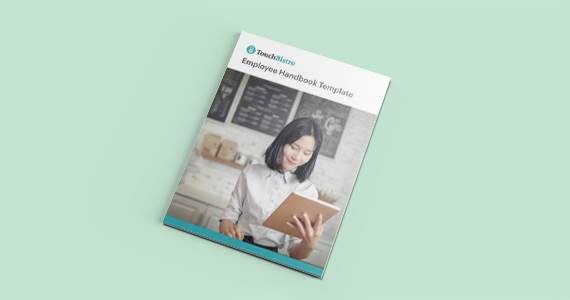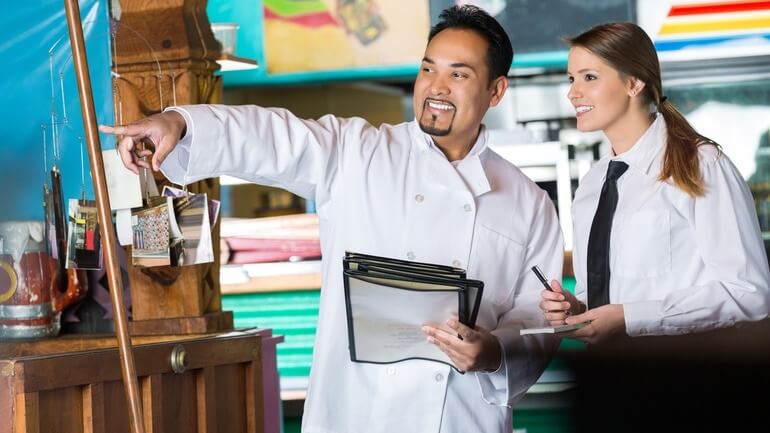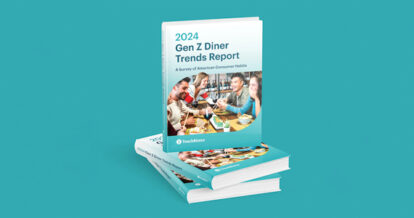A new hire checklist for restaurant employees can make the onboarding process easy and painless for all parties involved. Why reinvent the wheel every time a new hire joins your team when you can formalize the process?
After all, employees are the heart of your restaurant, and setting them up for success starts with the onboarding process. A thoughtful, organized onboarding experience can increase revenue, boost employee engagement, and reduce your restaurant turnover rate. Considering three in four restaurant workers leave their employers within a year, and the average cost of turnover can set a restaurant back as much as $5,864 per employee (ouch!), restaurateurs should pay special mind to this last one.
But we’re not here to spread doom and gloom. Instead, we want to provide you with the tools and information you need to prevent turnover and create a great first impression with new hires. In this guide to restaurant onboarding you’ll:
- Learn what employee onboarding is
- Get a new hire checklist for restaurant employees
- Learn the four Cs of successful employee onboarding
- Get tips for safe restaurant onboarding during COVID-19
Let’s get started!
What Is Restaurant Employee Onboarding?
Restaurant employee onboarding is the process of orienting new staff to your restaurant – sharing who you are, what you do, what they’ll do, what their coworkers do, and the tools and information necessary to get the job done. The process is sometimes referred to as organizational socialization and includes collecting paperwork, orienting new hires within your company’s culture, and providing restaurant employees with hands-on training.
Proper onboarding and a smooth transition into the workplace is important for many reasons:
- Can increase productivity by setting clear expectations
- Boosts employee morale
- Promotes compliance
- Improves retention and decreases employee turnover
Some restaurants (those with a small staff, for example) might assume that an informal onboarding process – something semi-structured but largely ad hoc – will suffice. But without a proper employee handbook and the fixed sequence of activities and events that characterize a formal restaurant onboarding procedure, you reduce your chances of getting your new hires off on the right foot.

Download your customizable template now to start your own handbook for your restaurant!
Your New Hire Checklist for Restaurant Employees
The simplest way to formalize your onboarding process is to implement a new hire checklist for restaurant employees. Start with the one we’ve created below, then customize it to meet the needs of your business. Here’s an overview of the process:
- Complete all necessary paperwork
- Set up direct deposit
- Communicate restaurant guidelines and policies
- Explain staff scheduling policies
- Set up new hires in your staff systems
- Provide hands-on menu training and tasting
- Provide mentorship and shadowing opportunities
- Give constructive feedback
Here’s a closer look at each step.

1. Complete all necessary paperwork
You’ll need to collect the following paperwork from your new hires.
For U.S. employees:
- Social Security Number (SSN)
- W-4 form
- I-9 form
- Employee contact information and emergency contact information
For Canadian employees:
- Social Insurance Number (SIN) card copy
- Form TD1 (Canada federal and provincial or territorial)
- Employee contact information and emergency contact information
Make it as easy and safe as possible for employees to share this information with you. Have them send you these forms via email or a secure cloud storage system like Google Drive or Dropbox. Be careful not to leave sensitive information out in the open. For non-tax-related employee information, you can simplify the process with a program like Google Forms.
Rules may differ based on where your restaurant is located, so always consult an HR professional to find out if you need any other paperwork from your new employees.
2. Set up direct deposit
Next, gather payroll authorization from your new hires so that you can pay them via direct deposit come payday. Direct deposit is more convenient and safer than check payments during the COVID-19 pandemic, as employees don’t need to be physically present to be paid.
Your restaurant payroll provider will tell you exactly what information you need to collect from employees. In most cases, you’ll need the employee’s bank name and address, account number, and routing number. If you use a payroll software that integrates with your POS, like Push Operations, the data collection process can be completely automated.
If you offer restaurant employee benefits, this is also a good time to enroll your new employees. Conduct a benefits orientation so that employees know what’s being offered to them and can get guidance on making the best choices for their needs. Then, have them select the benefits they want.
3. Communicate restaurant guidelines and policies
Studies have found that 50% of millennials haven’t read their employee handbooks. So, you’ll need to review the employee handbook in your restaurant orientation. Go over important topics like:
- Job responsibilities
- COVID-19 safety procedures
- Hygiene
- Uniform
- Systems and tech
- Attendance
- Customer service
- Security – including your restaurant loss prevention strategy
- Opening and closing shift procedures
Whether you need to revamp your handbook or create a new one, TouchBistro’s free restaurant employee handbook template can help.

Download your customizable template now to start your own handbook for your restaurant!
4. Explain staff scheduling policies
Shift scheduling processes vary from restaurant to restaurant, so don’t assume your new hire knows what to expect even if they’re an industry veteran.
Review U.S. or Canadian labor laws so that employees know their rights when it comes to overtime, minimum wage, breaks, shift notice, and requesting time off.
Your restaurant employee training should also include an overview of the process for requesting and accepting shifts, swapping shifts, shift lengths, and expectations for how far in advance staff will have of their schedules and how much they can expect to work each week.
While you can start scheduling with an employee schedule template, we suggest eventually switching to a POS-integrated tool like 7shifts to simplify this part of your restaurant orientation process.
5. Set up new hires in your staff systems
Next, create logins for your new hires on all of the tech systems that they’ll need to use on the job, such as your restaurant:
- POS
- Payroll platform
- Staff communication platform
- Scheduling platform
- Security system
Provide restaurant employee training on how to use these tools in your restaurant training manual, and info on where they can go if they need more help.
6. Hands-on menu training and tasting
Both front-of-house (FOH) and back-of-house (BOH) staff will benefit from having first-hand experience with your menu. Familiarize both teams with a menu tasting and training.
The FOH restaurant employee training should include:
- Familiarization with and/or memorization of the menu items
- A review of allergens and ingredients
- Pairing suggestions
- Upselling training
- A tasting of as many items as possible (this can be done during the first few weeks on the job)
The BOH restaurant employee training should entail:
- Familiarization with and/or memorization of recipes
- A tasting of as many items as possible to ensure consistency
- Allergen training
And if needed, help new staff obtain food handlers permits.
7. Pair new hires with mentors
Mentorship and shadowing help new staff feel supported and are critical parts of this
new hire checklist for restaurant employees.
Have newcomers shadow experienced staff for a set period of time (ex: 1 week, 2 weeks) or until they’ve proven they’re comfortable on their own. Have new cooks shadow more senior kitchen staff, assistant managers shadow general managers, and new servers shadow experienced servers.
8. Provide constructive feedback
Being the new kid on the block isn’t easy. Provide constructive feedback to help your new hires improve and give them a formal opportunity to voice concerns. Schedule one-on-one performance reviews every month for the first three months. To help them stay on track, create a checklist of goals for 30-, 60-, and 90-day milestones.
Here’s an example of such goals for a server.
30 day goals:
- Complete menu training
- Taste all items on the menu
- Obtain food handler’s permit
- Complete 30 hours of shadowing
60 days goals:
- Transition away from shadowing to working independently
- Successfully work the dinner rush
90 day goals:
- Successfully work opening and closing shifts
- Show upselling prowess by increasing average check size by 20%

The Four Cs of Successful Employee Onboarding
While the employee onboarding process can and often does differ between restaurants – especially if you’re currently in the midst of contactless hiring – ultimately the goal is the same: to build a committed, positive relationship between a new hire and their coworkers and managers, while also promoting consistent and on-brand service.
According to Dr. Talya Bauer of the SHRM Foundation, the best onboarding programs contain four key ingredients:
1. Compliance
Employees learn about the rules, regulations, and legalities governing your restaurant and/or the service industry. This level encompasses everything from waste management policies and employee training on restaurant scheduling software, to food safety inspections.
2. Clarification
Employees receive a breakdown of job-related responsibilities, accountabilities, and expectations. They also learn how their specific role – expo, hostess, line cook, or otherwise – fits into the bigger company structure and organizational hierarchy.
3. Culture
Broad in scope, culture is an umbrella term pointing to the ins and outs of your restaurant: values, ethics, best practices, and so on. Advertise your restaurant’s values loud and proud by including your mission statement and company story on your careers page. This tactic will help you attract candidates who will fit in with your team and who share your common goals. Hiring people who share your values can ultimately lead to longer tenure and greater job success
Familiarize your new hire with your restaurant’s unspoken rules, too – like not talking to sous chef Joe before he’s had his morning coffee, for example.
4. Connection
Employees gain many skills working in a restaurant, but arguably the biggest perk to a restaurant job – after the tips, of course – is the friendships and sense of kinship that emerge from spending so many long, busy hours together. It’s essential that new employees receive opportunities to forge and nurture these interpersonal relationships and information networks, both on the job and outside of working hours.
Help staff keep in touch by making contact information available or setting up a group chat for your team. Organize non-work-related team building and bonding activities like virtual trivia night or picnics.

Tips for Safe Restaurant Onboarding During COVID-19
Restaurant onboarding is typically very hands-on. However, you should do everything you can to mitigate risk during the pandemic. Aim to conduct as much of your hiring and onboarding virtually as possible.
Here are several ways to adapt your restaurant employee onboarding and training to be a COVID-safe process:
- Send and collect paperwork online to reduce contact.
- Conduct restaurant orientation via Zoom, Skype, FaceTime, or Google Hangouts.
- For in-person training (like menu tastings), try to make them one-on-one.
- Provide staff with appropriate PPE and check temperatures before each in-person onboarding phase (and before each shift!).
- Assign each restaurant mentor only one mentee to keep close contact limited during shadowing.
Restaurants would be nothing without their amazing teams. A smooth restaurant onboarding process can be the difference between an employee who thrives and one who abandons ship after just a few weeks. Use a new hire checklist for restaurant employees to formalize onboarding with ease and set your new hire up for success. Your checklist should be a living document; update it as your business grows.
Download your free employee handbook template
Sign up for our free weekly TouchBistro Newsletter







